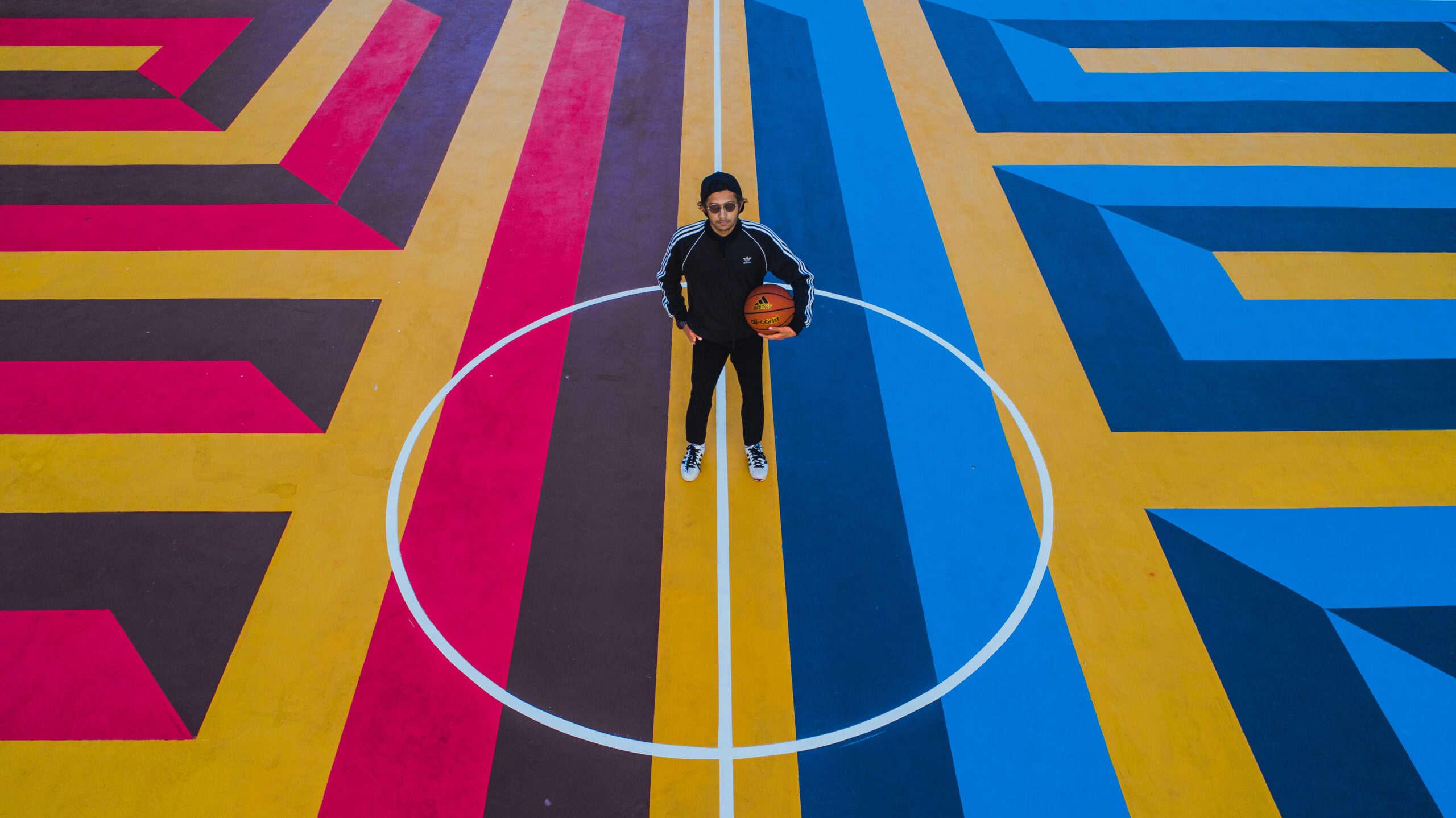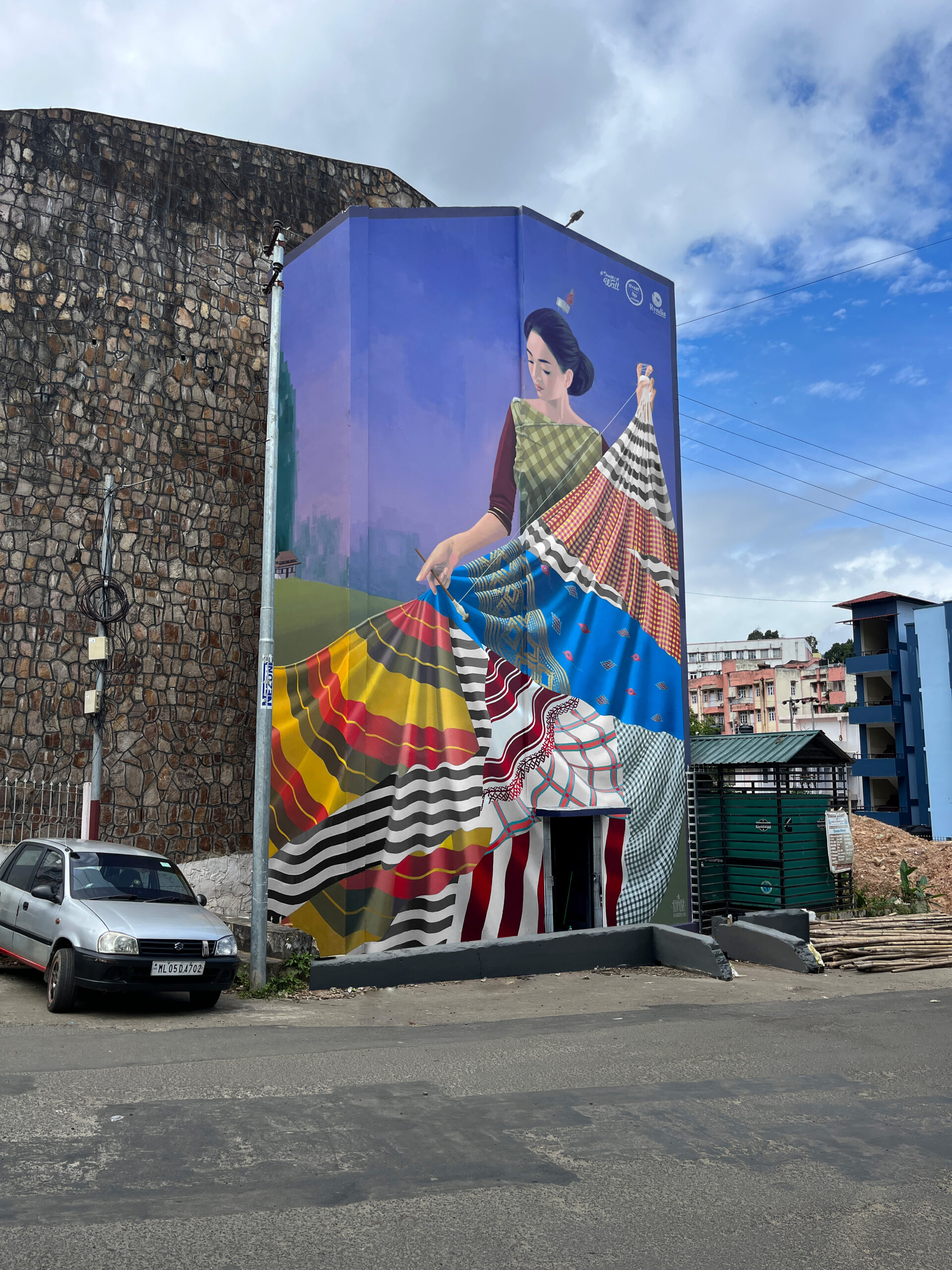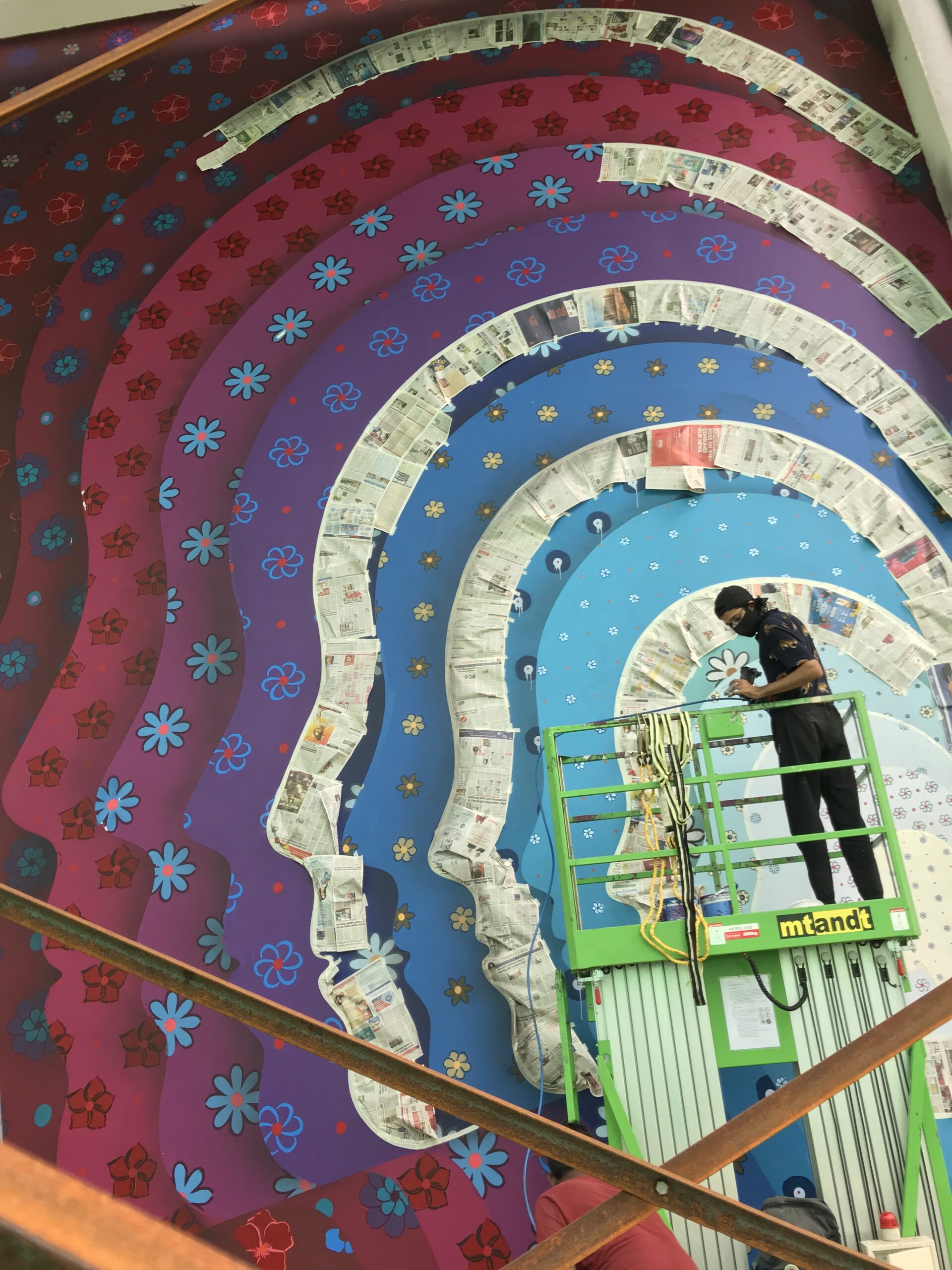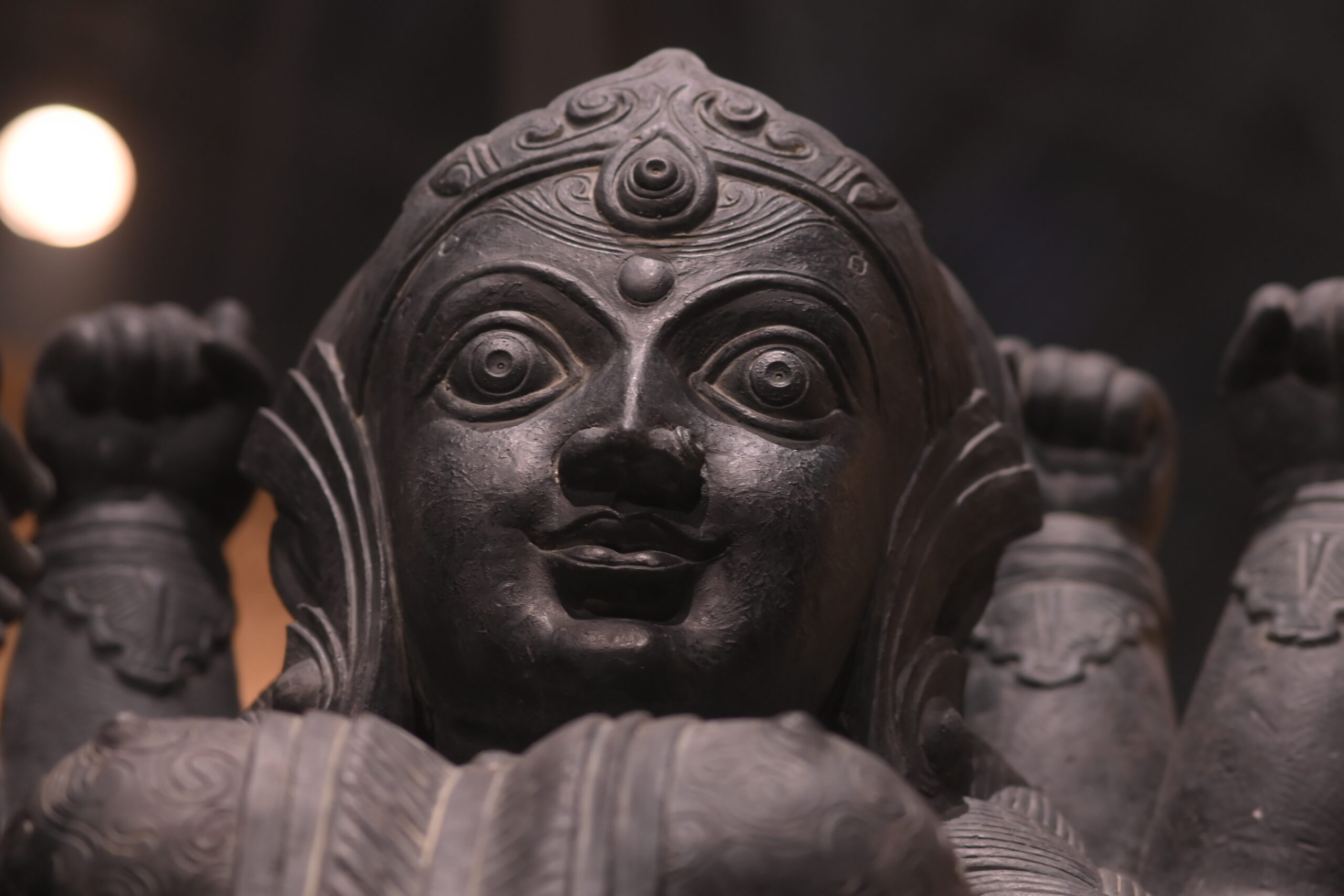It’s easy to forget that murals start small, many times with a sketch, a stencil, or in Siddharth Gohil’s case, a job in graphic design.
Before he ever touched a public wall, Gohil was working at St+art India Foundation, helping build visuals behind the scenes. Slowly, that role shifted. Watching senior artists, assisting on site, and spending more time outdoors than behind a screen, he found himself pulled toward street art, mainly for the sense of freedom and clarity it allowed.
Alongside his formal training in Graphic Design at MSU, Baroda, Gohil’s early understanding of composition came from growing up in a family of tailors, where patterns, cuts, and stitched seams were just part of daily life. Those early lessons still show up in his murals today, especially in the symmetry of tribal forms or the improvisational curves of abstract shapes. A recent mural ‘Threads of Tradition’ in Shillong stitched those threads together, bringing textile knowledge, cultural research, and street-scale painting into the same frame.
Art Fervour sat down with Siddharth Gohil AKA Khatra to talk about the early days of assisting, the politics of permission, and the mental calculus of painting six floors up on wet scaffolding.

It’s been nearly a decade since you first started painting walls. What were those early days like, from studying design, assisting others, and slowly stepping into your own practice?
“It started just after I graduated in 2016,” Siddharth says. “I joined St+art India Foundation as a graphic designer, but slowly I found myself getting drawn into the street art scene.” At first, he assisted national and international artists on large projects, an informal apprenticeship that laid the groundwork for his personal style. “It was a big learning phase. I was observing, helping out, and getting a feel for the process. Then I began getting opportunities to paint my own walls, and that’s when it really started to feel like something of my own.” Over time, those moments multiplied into a full practice and a deeper relationship with the street as a site for expression.
Your family background in tailoring and your training in design seem worlds apart but do you find that they shaped your eye for detail, form, or composition? Can you think of a mural where that connection became especially clear?
“There’s definitely a strong influence,” Gohil says. “Having a background in a tailor family, I’ve been heavily inspired from the clothes, its pattern, its intricate designs and forms, that have had a very major impact in my practice as well as a designer. And like, having that vision, it has helped me a lot to visualise the design and forms.”
You could see it clearly in a project he recently completed. “The mural I did last year in Shillong was completely inspired by tribal patterns, the way they create them, how those patterns represent their identity, and how they help hold the community together. That culture gave me a clearer sense of what I’m doing. It also made me realise this is the kind of work I want to keep doing. Painting something like that on such a large surface felt really different and honestly exciting.”

When you look back at your formal education, do you feel it gave you a foundation to build on or were there gaps that became clear once you stepped into public practice?
“Definitely, in some parts, I would say it laid my foundation, especially in terms of strong visualisation and design,” Gohil says. “Earlier, when I was a kid, I used to just draw letters, play with radium stickers. It was kind of a game for me.” That early instinct started to take shape more clearly during his Applied Arts training at MSU, Baroda. “After graduation, it all became the same thing, but now with rules, with proper design aspects. College gave me that base, and the foundation of design. And from there, I could take those tools and experiment in my own way. It’s not just randomness in my work.”
When you first started painting walls, what did the street offer that studio or commercial spaces couldn’t? Was it about autonomy, access, or something else altogether?
“For me, it was mostly freedom,” Gohil says. “And the amount of connectivity you get, there’s no barrier between you and your audience. It’s pure art form.” That direct line of communication, without curators or institutions mediating meaning, is what drew him in. “There’s no one explaining your art. You’re just directly communicating to the masses. That’s what motivates me and keeps me going.”
If you want to paint independently, you often have to negotiate permission on your own. What has that process been like? Do people usually understand what you’re doing or does it take some convincing?
While working with organisations can streamline access to walls, going solo is usually a slower, more uncertain process. “They generally don’t know what you’re trying to do at first,” Gohil says. “But I work with this foundation, so we try to show them pictures, show them what we’re doing on the big walls. We’re doing really beautiful things, and once they see that, they try to understand. Then they usually give permission.” Convincing the property owner, he says, is key. “That’s how you get permission if you’re going solo.” With organisations or brands, the process is more formalised and easier. “There are systems in place, brands get permission, and they even give a commission to the person donating the wall.”

Your murals are often precise in form, but the streets are anything but predictable. How do you move through that contrast especially when the wall, environment and surroundings shift your original plan?
“When I’m executing any work, I’ve usually done the groundwork beforehand, I know what I want to do and how to approach it. But once I’m actually there, on site, I start seeing things differently. The wall, the texture, the environment, it all adds something new.” Even with a structured plan in place, Gohil treats each wall as something that can shift mid-process. Precision might guide the start, but it’s flexibility that carries it through and without it, the process can easily turn haywire.
Rather than resist those shifts, he lets the surface shape the final work. “Sometimes I just go completely organic. I try to respond to the space, not control it. There are no fixed boundaries at that moment, it becomes more about what the wall is asking for.”
When you’re scouting for a wall, what tells you it’s the right place to paint? Is it about scale, structure, lighting?
The main aim always is to be ‘Seen’. “There are so many things we consider when we’re choosing a wall,” Gohil says. “But the major thing, I guess, is visibility. Where can more people see the work, on the go? Is it clearly visible from the road?” Public art only works if it’s actually public. “We also think about the neighbourhood, is it friendly, is it the kind of space where people can walk up and view the work? That’s really what we’re looking for.”

Are there cities or neighbourhoods where your work feels more at home, where the audience really connects with it? And are there places you’re hoping to work in next?
Some places feel familiar because of time spent there. Others feel incomplete because they’re still waiting. “I stayed in Delhi after graduation, so I’ve worked there the most,” Gohil says. “I’ve connected with more people, done more public work. It feels like a place I understand.” But he doesn’t want to be defined by one city. “I also want to explore more places, more cities and build that same kind of connection everywhere. I don’t want to think of just one place as mine. Every place should feel exciting and surprising.” Recently, that pull led him home. “In January, I went to my hometown in Gujarat. It’s a rural area, with small, beautiful villages. I haven’t painted there yet, but I really want to. I want to take a break, go back, and just paint for the community there. Especially the children.”
Have there been moments where the community saw something in your work that surprised you and interpretations you hadn’t expected, but stayed with you?
“There was one work at Sassoon Docks in Mumbai, where I painted with my friend Nikunj, we work as a duo sometimes,” he says. “We started working on an abstract composition together, with no prior sketch. It was totally organic.” The mural stretched across three sides of the building. No plan, no preparation, just reacting to the space as they went. “We just responded to the space and kept painting. And the way people interpreted it, it was so different from what we had visualised.” But instead of correcting them, they leaned into it. “People had so many different narratives about the work. It made us realise, yeah, that’s also a possibility. We really enjoyed that.”

Could you tell us about a moment of interaction with the local community, either during a mural or after it was completed, that really stayed with you?
Some murals invite conversations before the work is even done. Gohil remembers one such project in Shillong. “But people kept coming up to me while I was painting. Every day, they’d ask what I was making, what kind of pattern it was, who the figure was going to be on the wall.” What he remembers most isn’t the questions, but the fact that they kept coming. “They were working in the offices nearby, but they came back every day, really eager to see the finished piece. That whole process felt really close to me.”
Have you ever felt scared while working, especially on scaffolding or tall structures?
Not every wall offers stable ground. Gohil recalls one project that pushed him physically more than any before. “Yes,” he says. “It was my first time on bamboo scaffolding. It was really tricky, especially with the rain. Even if you’re wearing water shoes, you’re going to slip.” The space was narrow, less than a foot to move. “It was very difficult. Still, I’m glad I was able to pull it off. It was a six-floor building.” Even with safety gear, the experience is never comfortable. “Most times we work with lifts, which are more secure. You have harnesses, all the equipment. But with scaffolding, especially bamboo, it’s just harder. You can’t move around freely.”

Once a mural is finished, does it stay with you or do you leave it behind as part of that space?
“Most of the time, the whole process and the outcome of a project stays with me,” Gohil says. “I get carried away by it, and I carry it forward too.” Rather than closing something off, each mural opens up and builds on in the next one. “You keep thinking about it, and you want to do it again, but in a better way. You evolve through your last works. That same energy moves into whatever comes next.”
Anonymity has always played a complex role in street art. For you, was it a form of protection, a statement?
For Gohil, it wasn’t about secrecy, but it did offer a kind of buffer. “Earlier, I wasn’t that anonymous, mostly my college friends knew who I was. But over time, my personal and street art practice got mixed, and some photos got published. So right now, I’m not anonymous at all. I just do the same thing.” He understands why others choose to stay hidden. “They don’t want to get caught in the first place, or be judged through their identity. They want people to have an opinion based on the art, not who the person is, that’s the core idea, I think.”
There’s also the matter of risk. “In 2020, during the CAA-NRC protests, I tried to do something on the streets. The next day, all the posters were torn down. A couple of guys were trying to find out who did it, but luckily I hadn’t tagged my name anywhere, so I wasn’t caught.”
Hanif Kureshi left a huge mark on India’s street art community, both in terms of visual vocabulary and mentoring younger artists. What were your early interactions with him like, and what kind of impact did he have on your path?
“He’s the reason I’m into this art form,” Gohil says. “We’re from the same place. I knew him since I was in school.” Years later, during college, they crossed paths again at Navratri, a nine-day festival at MSU known for its alumni presence and its celebrated Fine Arts garba. “That’s when I showed him my work. After that, me and a few friends went to Delhi for the first street art festival to assist different artists, and from there, it just started.” From there, he spent close to ten years learning under him. “I worked with him for eight or nine years. Got advice from him so many times. We shared a lot of memories.” The absence still feels recent. “It’s still unbelievable that he’s not here anymore. But I’m really grateful I got to work with him. He was like a big brother. And we’re still trying to carry the vision he had.”

For younger artists stepping out of college and wanting to pursue street art, what should they keep in mind, especially around consent, legality, and the line between vandalism and public work? What do you wish more institutions taught?
There’s no shortcut. That’s the first thing Siddharth Gohil wants emerging artists to know. “The main thing is: take whatever knowledge you have, and go out on the streets. Practice. That’s how you learn. That’s how you figure it out.” But practice isn’t the same as carelessness. “Art schools don’t really talk about this. There’s nothing major on street art or graffiti. If they brought in artists, even for a couple of workshops, it could help students understand how different these forms actually are.”
He draws a clear distinction. “Graffiti started as a kind of protest. It was about tagging, vandalising, going against something. Street art is different. It’s more refined. Legal. You take permission. You think about the community. You consider where and how it will live.” That line, he says, isn’t always visible from the outside. “Most people just see something on Instagram and think, it looks cool. But they don’t see the physical and mental toll it takes. Or the risk. Or how hard it is to get permission, especially if you’re working solo.” Still, it’s not impossible. “If you explain your work, talk to the property owner, make them understand, most people are supportive. It’s about how you communicate. And about being mindful.”
If you were to imagine a public art ecosystem that supports long-term work, not just in metros, but in smaller towns and rural spaces too, what would that look like to you?
It starts at the local level. Not with institutions, but with the involvement of people. “More community projects, more involvement of local people, students, kids, this kind of participation makes it sustainable,” Gohil says. “When people get involved, they also get closer to the art form. They understand it.”
That proximity, he says, builds something more lasting than visibility. “It removes the distance. People come together for something. And I think this kind of activity can make it grow, for real.”
Conclusion:
There’s no grand plan, no five-year blueprint. For now, Siddharth just wants to keep painting more freely, in more places, and closer to the communities that made him want to do this in the first place. Rural walls, children watching from below, a bit of scaffolding, and enough time to figure it out. That’s the kind of future he’s building.
Keep an eye on his Instagram. You might spot him in your city next!







